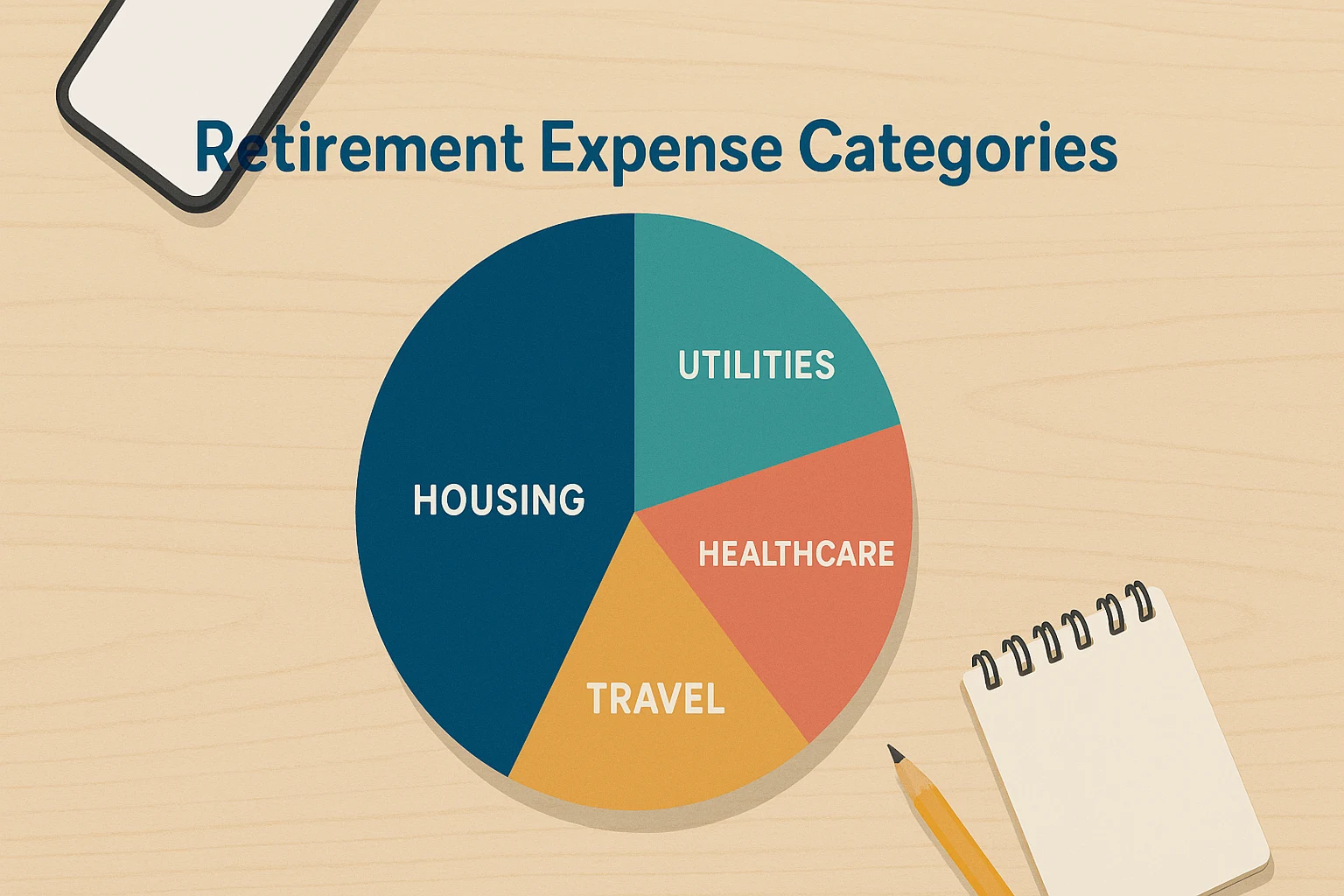Retire at 60 with $1M: Proven Strategies

Dreaming of retiring at 60 with $1 million? With some savvy planning and a clear picture of your lifestyle, it’s totally doable for many folks! You don’t need a bottomless bank account—just smart moves to stretch your money, grow it steadily, and keep expenses in check. This guide’s got you covered with practical tips on how to retire at 60 with 1 million dollars and make that money last — from withdrawal strategies to healthcare and investments. Ready to kickstart your retirement journey? Let’s do this! 🚀
Plan Your Retirement Now!Table of Contents
- Key Takeaways for Early Retirement Success
- Can You Retire at 60 with $1 Million?
- Mastering Safe Withdrawal Rates
- Crafting a Retirement Budget
- Navigating Healthcare Before Medicare
- Optimizing Social Security Benefits
- Smart Investment Drawdown Strategies
- Building a Resilient Retirement Portfolio
- Lifestyle Scenarios: Making $1 Million Work
- Your Retirement Viability Calculator
- FAQs About Retiring at 60 with $1M
- Conclusion: Start Your Retirement Journey Today
Your Retirement Viability Calculator
Use this tool to assess retiring at 60 with $1M based on your unique situation.
Retirement Viability Tool
Enter your details to see how sustainable your $1 million retirement plan is.
Your Retirement Snapshot 📈
Key Takeaways: How to Retire at 60 with 1 Million Dollars
Here’s the scoop on how to retire at 60 with $1 million:
- $1 Million Can Work: You can absolutely make it happen with thoughtful planning, clever budgeting, and a lifestyle that fits your vibe.
- Safe Withdrawal Rates are Crucial: Applying a safe withdrawal rate (3.5% to 4%) ensures your funds last.
- Budgeting and Healthcare are Key: Detailed budgeting and pre-Medicare planning (ages 60–65) are vital.
- Strategic Social Security and Investments: Timing Social Security and using tax-efficient drawdowns boost longevity.
- Flexibility and Annual Review: Stay adaptable and review your plan yearly.
How to Retire at 60 with 1 Million Dollars: The Big Picture
So, can a million dollars truly fund a retirement starting at 60 for 30, 35, or even 40 years? The answer depends on your personal situation. For instance, these factors play a significant role:
- Your annual spending needs: A frugal lifestyle makes a $1M retirement at 60 more achievable than a lavish one.
- Your health: Unexpected medical costs can challenge your plan.
- Your Social Security benefits: Claim timing impacts income.
- Your investment returns: Portfolio performance matters.
- Inflation: Rising costs add pressure over decades.
- Your flexibility: Willingness to adjust spending helps.
For some, $1 million is enough with careful management. Others may need part-time work or a modest lifestyle. Running your numbers is essential. We’ll show you how!

how to retire at 60 with 1 million dollars: Safe Withdrawal Rates
A cornerstone of how to retire at 60 with 1 million dollars is the Safe Withdrawal Rate (SWR). This is the percentage of your portfolio you can withdraw annually, adjusted for inflation, without depleting funds. Moreover, it’s based on historical market returns, balancing income and longevity.
The 4% Rule: A Classic Guideline
For years, the “4% Rule” has guided retirement planning. It suggests withdrawing 4% of your initial portfolio in year one, then adjusting for inflation annually.
How it works: With $1,000,000, a 4% rate means $40,000 in year one. If inflation is 3% in year two, you’d withdraw $41,200, and so on.
Pros of the 4% Rule:
- Simplicity: Easy to apply.
- Historical Basis: Supported by studies, such as one from the Financial Planning Association, showing success over 30 years.
Cons for Early Retirement:
- Longer Time Horizons: Assumes 30 years; at 60, you may need 35–40+ years.
- Sequence of Returns Risk: Early downturns hurt when withdrawals are high.
- Market Volatility: Lower future returns may make 4% less safe.
A Safer 3.5% Rule for a Long Retirement
For a longer retirement, a 3.5% SWR is often recommended.
How it works: With $1,000,000, you’d withdraw $35,000 in year one—$5,000 less than 4%, but safer long-term.
Pros:
- Increased Longevity: Funds likely last 35–40+ years.
- Market Protection: Buffers against downturns.
- Peace of Mind: Reduces stress.
Cons:
- Lower Income: Requires tighter budgeting.
Comparing Withdrawal Rates
| Withdrawal Rate | Initial Annual Income | Difference from 4% | Potential Longevity |
|---|---|---|---|
| 4.0% | $40,000 | – | 30–35 years (moderate risk) |
| 3.5% | $35,000 | -$5,000 | 35–40+ years (lower risk) |
Ultimately, choosing between 3.5% and 4% depends on your risk tolerance and goals.
“The difference between a 3.5% and 4% withdrawal rate might seem small, but over a 30-year retirement, it can mean the difference between running out of money and having a secure financial future.” — Financial Planning Wisdom
Crafting a Retirement Budget: Every Dollar Counts
Budgeting is critical when retiring at 60 with $1M, aligning spending with your portfolio’s income (e.g., $35,000–$40,000). It’s about strategic allocation, not just cuts. Tools in our 2025 budgeting guide can simplify this process.
Understanding Your Expenses
First, categorize expenses:
- Fixed Expenses: Consistent costs.
- Housing (mortgage/rent, taxes, insurance)
- Utilities (electricity, water)
- Insurance (auto, home, health)
- Debt payments (ideally none!)
- Subscriptions (streaming, gym)
- Variable Expenses: Fluctuating costs.
- Food (groceries, dining out)
- Transportation (gas, maintenance)
- Healthcare (co-pays, prescriptions)
- Entertainment & Hobbies (travel, events)
- Clothing & Personal Care
- Gifts & Charity
Tips for a $35,000–$40,000 Budget
To make a $1M plan work, try these adjustments:
- Housing: Downsize or relocate to a low-cost area.
- Transportation: Use one car or a fuel-efficient model.
- Food: Cook at home and limit dining out.
- Entertainment & Travel: Opt for local or off-peak travel.
- Healthcare: Budget for premiums and out-of-pocket costs.
- Debt: Pay off high-interest debt.

Sample Budget for Retiring at 60 with $1M
| Category | Monthly Budget | Annual Budget | Notes |
|---|---|---|---|
| Housing (paid off) | $800 | $9,600 | Property taxes, insurance, maintenance |
| Utilities | $250 | $3,000 | Electricity, water, internet, phone |
| Groceries | $400 | $4,800 | Mostly home-cooked meals |
| Transportation | $200 | $2,400 | Gas, insurance, maintenance (one car) |
| Healthcare (pre-Medicare) | $600 | $7,200 | ACA premium, deductibles, co-pays |
| Personal Care/Misc | $150 | $1,800 | Haircuts, toiletries, small purchases |
| Entertainment/Hobbies | $300 | $3,600 | Dining out, movies, local activities |
| Contingency/Buffer | $300 | $3,600 | Unexpected expenses, small trips |
| Total | $3,000 | $36,000 | Remaining $2,000 for travel/one-offs |
This budget illustrates a $36,000 annual plan with a buffer.
Navigating Healthcare Before Medicare (Ages 60–65)
Healthcare is a major challenge in a $1M-at-60 plan, with Medicare starting at 65, leaving a five-year gap. Explore options in our early retiree health insurance guide to find affordable coverage.
Your Healthcare Options
- COBRA: Continue your employer’s plan for 18–36 months.
- Pros: Same plan and doctors.
- Cons: Full premium plus fees—often thousands monthly.
- Affordable Care Act (ACA) Marketplace:
- Pros: Subsidies for low income (e.g., $35,000–$40,000) lower premiums.
- Cons: High deductibles; manage AGI for subsidies.
- Spouse’s Health Plan:
- Pros: Affordable if your spouse works.
- Cons: Tied to their job.
- Health Sharing Ministries:
- Pros: Cheaper than insurance.
- Cons: Limited coverage; use cautiously.
Budgeting for Healthcare Costs
Budget $500–$800 monthly for premiums and $200–$300 for out-of-pocket costs per person.
Smart Investment Drawdown Strategies
Withdrawing your $1 million wisely minimizes taxes and helps ensure steady income. Consider funds in our Dividend Aristocrats guide for reliable income streams.
The Bucket Strategy
Organize investments into buckets:
- Bucket 1 (Cash, 1–3 years): High-yield savings for short-term needs.
- Bucket 2 (Income, 3–10 years): Bonds or dividend stocks.
- Bucket 3 (Growth, 10+ years): Stocks to beat inflation.
Tax-Efficient Withdrawal Order
Minimize taxes in this order:
- Taxable Accounts: Pay capital gains, control AGI.
- Tax-Deferred Accounts: Taxed as income; RMDs at 73.
- Tax-Free Accounts (Roth): Tax-free withdrawals, save for last.
Portfolio Rebalancing and Flexibility
Rebalance annually and adjust withdrawals based on market performance.
Building a Resilient Retirement Portfolio
Your portfolio must balance income, growth, and risk management.
Asset Allocation for Age 60
A guideline:
- Equities (40–60%): Index funds, ETFs, dividend stocks.
- Fixed Income (30–50%): Short-to-intermediate bonds.
- Cash (5–10%): 1–3 years of expenses.
Diversification and Inflation Protection
Diversify across asset classes and include TIPS to combat inflation.
Lifestyle Scenarios: Making $1 Million Work
Explore how $1 million supports lifestyles with a $35,000–$40,000 draw.
The Frugal Retiree
- Income: $35,000/year (3.5% SWR)
- Traits: Mortgage-free, low-cost area, home cooking.
- Viability: High with delayed Social Security.
The Moderate Retiree
- Income: $40,000/year (4% SWR), later Social Security.
- Traits: Small mortgage, occasional dining, domestic travel.
- Viability: Medium-high; needs monitoring.
The Part-Time Work Retiree
- Income: $35,000/year + $10,000–$20,000 from work.
- Traits: Supplements income, enjoys work, more travel.
- Viability: Very high; reduces portfolio strain.

Frequently Asked Questions About Retiring at 60 with $1M
Conclusion: Start Your Retirement Journey Today
Retiring at 60 with $1 million is achievable with smart planning. Tweak withdrawals to make your money last, stay on top of healthcare, time Social Security wisely, and keep a balanced portfolio. Most importantly, build a flexible plan you revisit each year—life changes, and your plan should too. Try the calculator, make one improvement this week, and keep your eyes on the long game. You’ve got this. 🥳
This content is for informational purposes only and not financial advice. Consult a professional before making financial decisions.


Optimizing Social Security Benefits
Social Security timing is crucial for a 60-and-$1M plan. Timing your claim impacts your income significantly.
Claiming Options and Impacts
Strategies for Age 60 Retirement
Rely on your portfolio until at least 62. Options include:
Example: FRA benefit at 67 of $2,000/month: